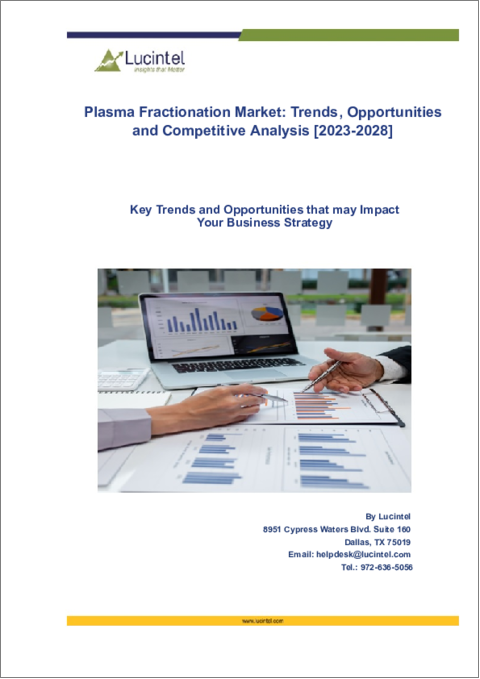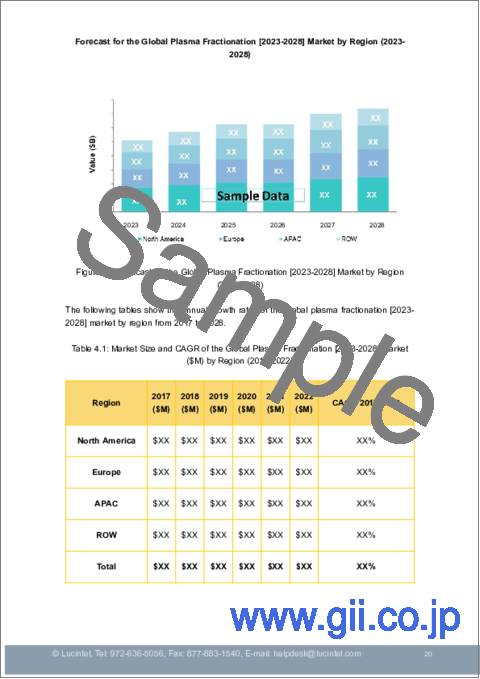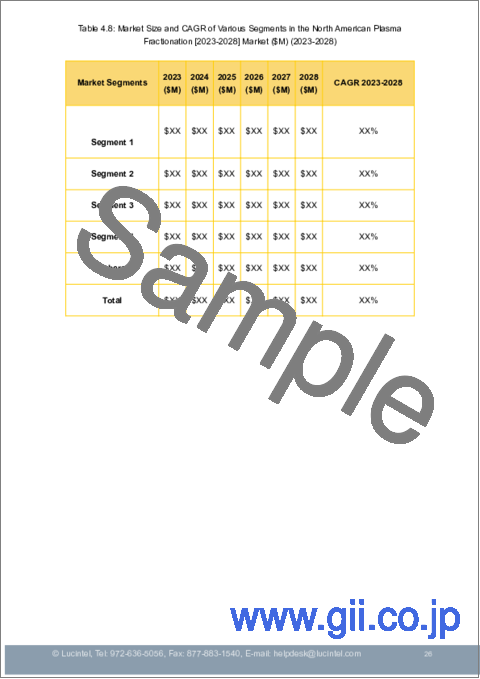|
|
市場調査レポート
商品コード
1263928
血漿分画市場:動向、機会および競合分析(2023年~2028年)Plasma Fractionation Market: Trends, Opportunities and Competitive Analysis [2023-2028] |
||||||
|
● お客様のご希望に応じて、既存データの加工や未掲載情報(例:国別セグメント)の追加などの対応が可能です。 詳細はお問い合わせください。 |
|||||||
| 血漿分画市場:動向、機会および競合分析(2023年~2028年) |
|
出版日: 2023年04月01日
発行: Lucintel
ページ情報: 英文 150 Pages
納期: 3営業日
|
- 全表示
- 概要
- 目次
世界の血漿分画の市場規模は、2023年~2028年にかけて7%のCAGRで拡大し、2028年までに427億米ドルに達すると予測されています。この市場の主な促進要因は、高齢者人口の増加、呼吸器疾患の有病率の上昇、さまざまな治療用途における免疫グロブリンの使用の増加です。
当レポートでは、世界の血漿分画市場について調査し、市場の概要とともに、製品別、手法別、用途別、最終用途産業別、地域別動向、および市場に参入する企業のプロファイルなどを提供しています。
目次
第1章 エグゼクティブサマリー
第2章 世界の血漿分画市場:市場力学
第3章 市場動向と予測分析、2017年~2028年
- マクロ経済の動向(2017年~2022年)と予測(2023年~2028年)
- 世界の血漿分画市場の動向(2017年~2022年)と予測(2023年~2028年)
- 世界の血漿分画市場、製品別
- アルブミン
- 免疫グロブリン
- 凝固因子
- プロテアーゼ阻害剤
- その他
- 世界の血漿分画市場、手法別
- 遠心分離
- 深層ろ過
- クロマトグラフィ
- その他
- 世界の血漿分画市場、用途別
- 神経学
- 血液学
- 腫瘍学
- 免疫学
- 呼吸器科
- その他
- 世界の血漿分画市場、最終用途産業別
- 病院・診療所
- 臨床研究
- その他
第4章 市場動向と予測分析、地域別、2017年~2028年
- 世界の血漿分画市場、地域別
- 北米の血漿分画市場
- 欧州の血漿分画市場
- アジア太平洋の血漿分画市場
- その他の地域の血漿分画市場
第5章 競合の分析
第6章 成長機会と戦略分析
- 成長機会分析
- 世界の血漿分画市場における新たな動向
- 戦略分析
第7章 主要参入企業の企業プロファイル
- Grifols
- CSL
- Takeda Pharmaceutical
- Octapharma
- Kedrion
Plasma Fractionation Market Trends and Forecast
The future of the plasma fractionation market looks promising with opportunities in hospitals & clinics and clinical research. The global plasma fractionation market is expected to reach an estimated $42.7 billion by 2028 with a CAGR of 7% from 2023 to 2028. The major drivers for this market are rising geriatric population, increasing prevalence of respiratory diseases, and growing use of immunoglobulin in different therapeutic applications.
Plasma Fractionation Market by Product, Method, Application, End Use Industry, and Region
A more than 150-page report is developed to help in your business decisions. A sample figure with some insights is shown below.
Plasma Fractionation Market by Segments
Plasma Fractionation Market by Segment
The study includes trends and forecast for the global plasma fractionation market by product, method, application, end use industry, and region, as follows:
Plasma Fractionation Market by Product [Value ($B) Shipment Analysis from 2017 to 2028]:
Albumin
Immunoglobulins
Intravenous immunoglobulins
Subcutaneous immunoglobulins
Others
Coagulation Factors
Factor VIII
Factor IX
Von Willebrand Factor
Prothrombin Complex Concentrates
Fibrinogen Concentrates
Others
Protease Inhibitors
Others
Plasma Fractionation Market by Method [Value ($B) Shipment Analysis from 2017 to 2028]:
Centrifugation
Depth Filtration
Chromatography
Others
Plasma Fractionation Market by Application [Value ($B) Shipment Analysis from 2017 to 2028]:
Neurology
Hematology
Oncology
Immunology
Pulmonology
Others
Plasma Fractionation Market by End Use Industry [Value ($B) Shipment Analysis from 2017 to 2028]:
Hospitals & Clinics
Clinical Research
Others
Plasma Fractionation Market by Region [Value ($B) Shipment Analysis from 2017 to 2028]:
North America
Europe
Asia Pacific
The Rest of the World
List of Plasma Fractionation Companies
Companies in the market compete on the basis of product quality offered. Major players in this market focus on expanding their manufacturing facilities, R&D investments, infrastructural development, and leverage integration opportunities across the value chain. With these strategies, plasma fractionation companies cater to increasing demand, ensure competitive effectiveness, develop innovative products & technologies, reduce production costs, and expand their customer base. Some of the plasma fractionation companies profiled in this report include-
Grifols
CSL
Takeda Pharmaceutical
Octapharma
Kedrion
Plasma Fractionation Market Insights
Lucintel forecasts that immunoglobulin will remain the largest product segment over the forecast period due to the increasing prevalence of infections and disorders and its extensive use in treatment, diagnosis, and administration of metabolic diseases.
Hospitals & clinics are expected to remain the largest end use industry segment due to the extensive use of plasma fractionation among hospitals and clinics to treat various diseases.
North America will remain the largest region due to an increase in the quantity of plasma collection facilities, rise in the demand for immunoglobulin, and growing number of elderly people with hereditary diseases in the region.
Features of the Plasma Fractionation Market
Market Size Estimates: Plasma fractionation market size estimation in terms of value ($B)
Trend And Forecast Analysis: Market trends (2017-2022) and forecast (2023-2028) by various segments and regions.
Segmentation Analysis: Plasma fractionation market size by various segments, such as product, method, application, end use industry, and region
Regional Analysis: Plasma fractionation market breakdown by North America, Europe, Asia Pacific, and the Rest of the World.
Growth Opportunities: Analysis on growth opportunities in different products, methods, applications, end use industries, and regions for the plasma fractionation market.
Strategic Analysis: This includes M&A, new product development, and competitive landscape for the plasma fractionation market.
Analysis of competitive intensity of the industry based on Porter's Five Forces model.
FAQ
Q1. What is the plasma fractionation market size?
Answer: The global plasma fractionation market is expected to reach an estimated $42.7 billion by 2028.
Q2. What is the growth forecast for plasma fractionation market?
Answer: The global plasma fractionation market is expected to grow with a CAGR of 7% from 2023 to 2028.
Q3. What are the major drivers influencing the growth of the plasma fractionation market?
Answer: The major drivers for this market are rising geriatric population, increasing prevalence of respiratory diseases, and growing use of immunoglobulin in different therapeutic applications.
Q4. What are the major segments for plasma fractionation market?
Answer: The future of the plasma fractionation market looks promising with opportunities in hospitals & clinics and clinical research.
Q5. Who are the key plasma fractionation companies?
Answer: Some of the key plasma fractionation companies are as follows:
Grifols
CSL
Takeda Pharmaceutical
Octapharma
Kedrion
Q6. Which plasma fractionation segment will be the largest in the future?
Answer: Lucintel forecasts that immunoglobulin will remain the largest product segment over the forecast period due to the increasing prevalence of infections and disorders and its extensive use for the treatment, diagnosis, and administration of metabolic diseases.
Q7. In plasma fractionation market, which region is expected to be the largest in next 5 years?
Answer: North America will remain the largest region due to increase in quantity of plasma collection facilities, rise in the demand for immunoglobulin, and growing number of elderly people with hereditary diseases in the region.
Q8. Do we receive customization in this report?
Answer: Yes, Lucintel provides 10% Customization Without any Additional Cost.
This report answers following 11 key questions
- Q.1. What are some of the most promising, high-growth opportunities for the plasma fractionation market by product (albumin, immunoglobulins, coagulation factors, protease inhibitors, and others), method (centrifugation, depth filtration, chromatography, and others), application (neurology, hematology, oncology, immunology, pulmonology, and others), end use industry (hospitals & clinics, clinical research, and others), and region (North America, Europe, Asia Pacific, and the Rest of the World)?
- Q.2. Which segments will grow at a faster pace and why?
- Q.3. Which region will grow at a faster pace and why?
- Q.4. What are the key factors affecting market dynamics? What are the key challenges and business risks in this market?
- Q.5. What are the business risks and competitive threats in this market?
- Q.6. What are the emerging trends in this market and the reasons behind them?
- Q.7. What are some of the changing demands of customers in the market?
- Q.8. What are the new developments in the market? Which companies are leading these developments?
- Q.9. Who are the major players in this market? What strategic initiatives are key players pursuing for business growth?
- Q.10. What are some of the competing products in this market and how big of a threat do they pose for loss of market share by material or product substitution?
- Q.11. What M&A activity has occurred in the last 5 years and what has its impact been on the industry?
Table of Contents
1. Executive Summary
2. Global Plasma Fractionation Market: Market Dynamics
- 2.1: Introduction, Background, and Classifications
- 2.2: Supply Chain
- 2.3: Industry Drivers and Challenges
3. Market Trends and Forecast Analysis from 2017 to 2028
- 3.1: Macroeconomic Trends (2017-2022) and Forecast (2023-2028)
- 3.2: Global Plasma Fractionation Market Trends (2017-2022) and Forecast (2023-2028)
- 3.3: Global Plasma Fractionation Market by Product
- 3.3.1: Albumin
- 3.3.2: Immunoglobulins
- 3.3.2.1: Intravenous immunoglobulins
- 3.3.2.2: Subcutaneous immunoglobulins
- 3.3.2.3: Others
- 3.3.3: Coagulation Factors
- 3.3.3.1: Factor VIII
- 3.3.3.2: Factor IX
- 3.3.3.3: Von Willebrand Factor
- 3.3.3.4: Prothrombin Complex Concentrates
- 3.3.3.5: Fibrinogen Concentrates
- 3.3.3.6: Others
- 3.3.4: Protease Inhibitors
- 3.3.5: Others
- 3.4: Global Plasma Fractionation Market by Method
- 3.4.1: Centrifugation
- 3.4.2: Depth Filtration
- 3.4.3: Chromatography
- 3.4.4: Others
- 3.5: Global Plasma Fractionation Market by Application
- 3.5.1: Neurology
- 3.5.2: Hematology
- 3.5.3: Oncology
- 3.5.4: Immunology
- 3.5.5: Pulmonology
- 3.5.6: Others
- 3.6: Global Plasma Fractionation Market by End Use Industry
- 3.6.1: Hospitals & Clinics
- 3.6.2: Clinical Research
- 3.6.3: Others
4. Market Trends and Forecast Analysis by Region from 2017 to 2028
- 4.1: Global Plasma Fractionation Market by Region
- 4.2: North American Plasma Fractionation Market
- 4.2.1: North American Plasma Fractionation Market by Product: Albumin, Immunoglobulins, Coagulation Factors, Protease Inhibitors, and Others
- 4.2.2: North American Plasma Fractionation Market by End Use Industry: Hospitals & Clinics, Clinical Research, and Others
- 4.3: European Plasma Fractionation Market
- 4.3.1: European Plasma Fractionation Market by Product: Albumin, Immunoglobulins, Coagulation Factors, Protease Inhibitors, and Others
- 4.3.2: European Plasma Fractionation Market by End Use Industry: Hospitals & Clinics, Clinical Research, and Others
- 4.4: APAC Plasma Fractionation Market
- 4.4.1: APAC Plasma Fractionation Market by Product: Albumin, Immunoglobulins, Coagulation Factors, Protease Inhibitors, and Others
- 4.4.2: APAC Plasma Fractionation Market by End Use Industry: Hospitals & Clinics, Clinical Research, and Others
- 4.5: ROW Plasma Fractionation Market
- 4.5.1: ROW Plasma Fractionation Market by Product: Albumin, Immunoglobulins, Coagulation Factors, Protease Inhibitors, and Others
- 4.5.2: ROW Plasma Fractionation Market by End Use Industry: Hospitals & Clinics, Clinical Research, and Others
5. Competitor Analysis
- 5.1: Product Portfolio Analysis
- 5.2: Operational Integration
- 5.3: Porter's Five Forces Analysis
6. Growth Opportunities and Strategic Analysis
- 6.1: Growth Opportunity Analysis
- 6.1.1: Growth Opportunities for the Global Plasma Fractionation Market by Product
- 6.1.2: Growth Opportunities for the Global Plasma Fractionation Market by Method
- 6.1.3: Growth Opportunities for the Global Plasma Fractionation Market by Application
- 6.1.4: Growth Opportunities for the Global Plasma Fractionation Market by End Use Industry
- 6.1.5: Growth Opportunities for the Global Plasma Fractionation Market by Region
- 6.2: Emerging Trends in the Global Plasma Fractionation Market
- 6.3: Strategic Analysis
- 6.3.1: New Product Development
- 6.3.2: Capacity Expansion of the Global Plasma Fractionation Market
- 6.3.3: Mergers, Acquisitions, and Joint Ventures in the Global Plasma Fractionation Market
- 6.3.4: Certification and Licensing
7. Company Profiles of Leading Players
- 7.1: Grifols
- 7.2: CSL
- 7.3: Takeda Pharmaceutical
- 7.4: Octapharma
- 7.5: Kedrion




